Sashimi is one of my favorite meals to treat myself to. It's a Japanese delicacy for a reason – nothing is as delicious as some fresh fish. While sashimi is definitely delicious, is sashimi healthy?
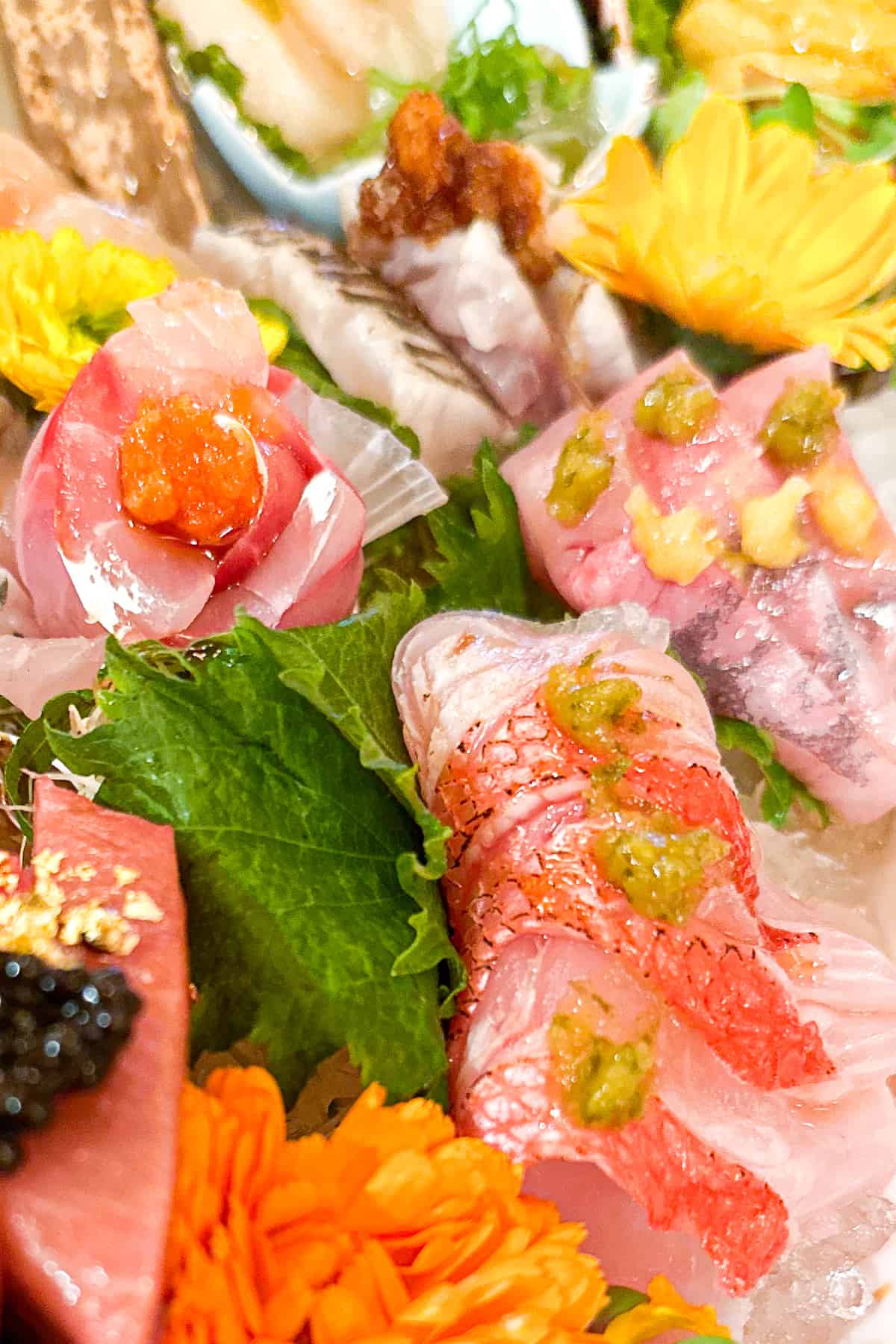
Sashimi is very healthy given that it is predominantly made of protein and contains omega-3 fatty acids and other essential vitamins. Given that it is not cooked with sauces and oil and is only dipped in soy sauce, which is a very low-calorie condiment, this is one of the cleanest meals you can have when eating out.
In this guide, we’ll be looking at why sashimi is healthy and some healthy choices for sashimi.
💭 What is sashimi?
Sashimi is a delicacy in Japanese cuisine that consists of sliced raw fish or raw meat. It is often dipped in soy sauce to season and eaten as is.
⚖️ Sashimi vs. Sushi
Sashimi and sushi both have sushi-grade fresh fish as their common ingredient The difference is that sushi consists of the raw fish either rolled in sushi rice and nori (also known as maki sushi) or topped above a bed of vinegared rice, known as nigiri sushi. Meanwhile, sashimi just consists of sliced fish.
Because of this, sashimi has fewer calories and has no carbs. This can be great for people who prefer to eat a low-carb diet.
Depending on the type of sushi, sushi can be a calorie bomb that can be less than ideal for dieting purposes. Some sushi rolls include high-fat ingredients such as cream cheese and shrimp tempura, which add a lot of extra calories.
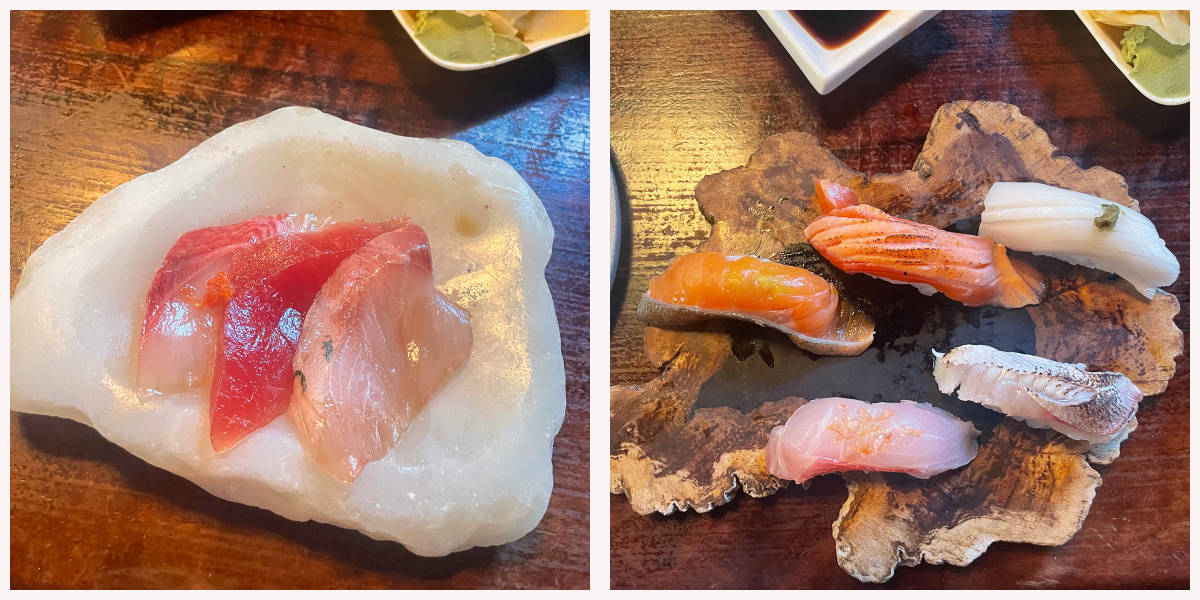
To learn more about different types of healthy Japanese food options, check out my healthy Japanese food guide.
🍎 Health Benefits of Eating Sashimi
Rich in protein – Sashimi predominantly consists of protein and is a great lean protein source, This is especially important to consume after workouts to support muscle growth.
Great for weight loss – Protein also makes you feel fuller compared to other macronutrients which allow you to eat fewer calories while still feeling full. To learn more about how protein affects hunger, check out this article on hunger hormones.
No need to cook or mix with high-calorie ingredients – Sashimi only requires around a tablespoon of soy sauce or a light carpaccio sauce at most to season. It does not require cooking, which eliminates any oil usage or additional calories. Ordering sashimi is a great way to eat a healthy meal at a restaurant since all sushi restaurants prepare it the same and can’t douse it in butter and oil!
Good Source of Omega-3s – Sashimi is packed with omega-3 fatty acids, which are heart-healthy fats. The American Heart Association has found it to help lower blood pressure and prevent heart disease. For more info on the benefits of omega-3s, check out this article on omega-3 benefits.
📖 5 Kinds Of Sashimi and Nutrition Info
Ahi Tuna
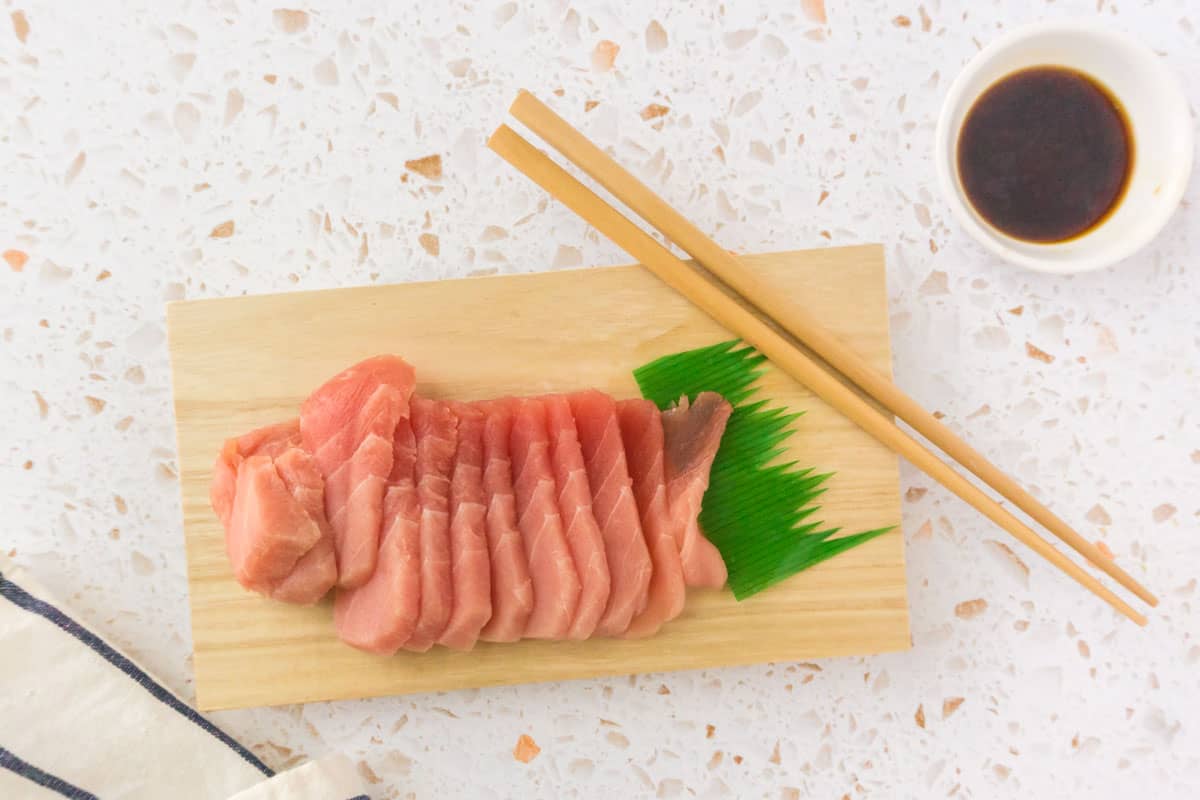
Tuna is one of the most popular types of sashimi. It has a deep pink-red color with a slightly firm texture and a slightly sweet taste.
Tuna is the star of the sashimi show in Japanese cuisine and is the fish that Japanese restaurants wake up in the wee hours of the morning for at the famous Tsujiki fish market in Japan.
So what is the nutrition profile for tuna sashimi like? Is tuna sashimi healthy?
| Tuna Sashimi | |||||
| Ingredient | Quantity | Calories | Protein (g) | Fat (g) | Carbs (g) |
|---|---|---|---|---|---|
| Tuna | 4 oz | 124 | 27.6 | 0.6 | 0 |
| Soy Sauce | 1 tbsp | 10 | 1 | 1 | 0 |
| Total | 134 | 28.6 | 1.6 | 0 | |
Tuna sashimi can be very healthy – one 4-ounce serving of tuna sashimi is 134 of calories with 29 grams of protein, 1.6 grams of fat, and 0 grams of carbs.
It’s worth noting that there are various different cuts of tuna out there including chutoro and otoro that are on the fattier side, and may be more calorie-dense. You can either opt for leaner cuts, such as akami, or portion the fattier cuts mindfully.
Tune is also a popular option for making healthy poke bowls given it's great macronutrient profile.
Hamachi (Yellowtail)
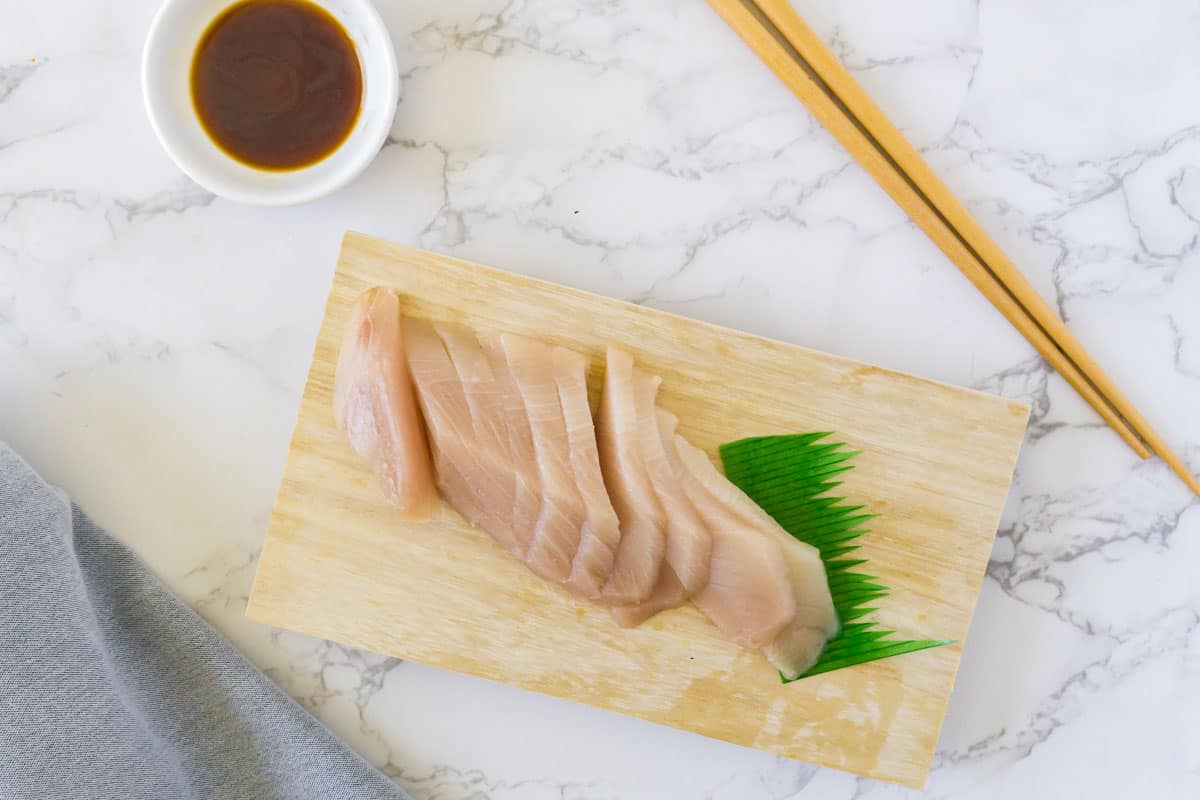
Hamachi, or Yellowtail, is a delicious type of sashimi that is a light pink color. It has a mild sweet taste and a slightly firm texture. It is another great option for leaner sashimi. This sashimi has an especially high omega-3 content.
So what is the nutrition profile for hamachi sashimi like? Is hamachi sashimi healthy?
| Hamachi Sashimi | |||||
| Ingredient | Quantity | Calories | Protein (g) | Fat (g) | Carbs (g) |
|---|---|---|---|---|---|
| Hamachi | 4 oz | 164 | 26 | 5.9 | 0 |
| Soy Sauce | 1 tbsp | 10 | 1 | 1 | 0 |
| Total | 174 | 27 | 6.9 | 0 | |
Hamachi sashimi can be very healthy – one 4-ounce serving of hamachi sashimi is 174 of calories with 27 grams of protein, 7 grams of fat, and 0 grams of carbs, and it’s packed with omega -3s.
It tends to have slightly more fats from the omega-3 fatty acids, which are healthy but do make the fish higher in calories.
Hamachi is delicious when seared with a torch or made as a hamachi crudo for a delicious appetizer.
Scallop
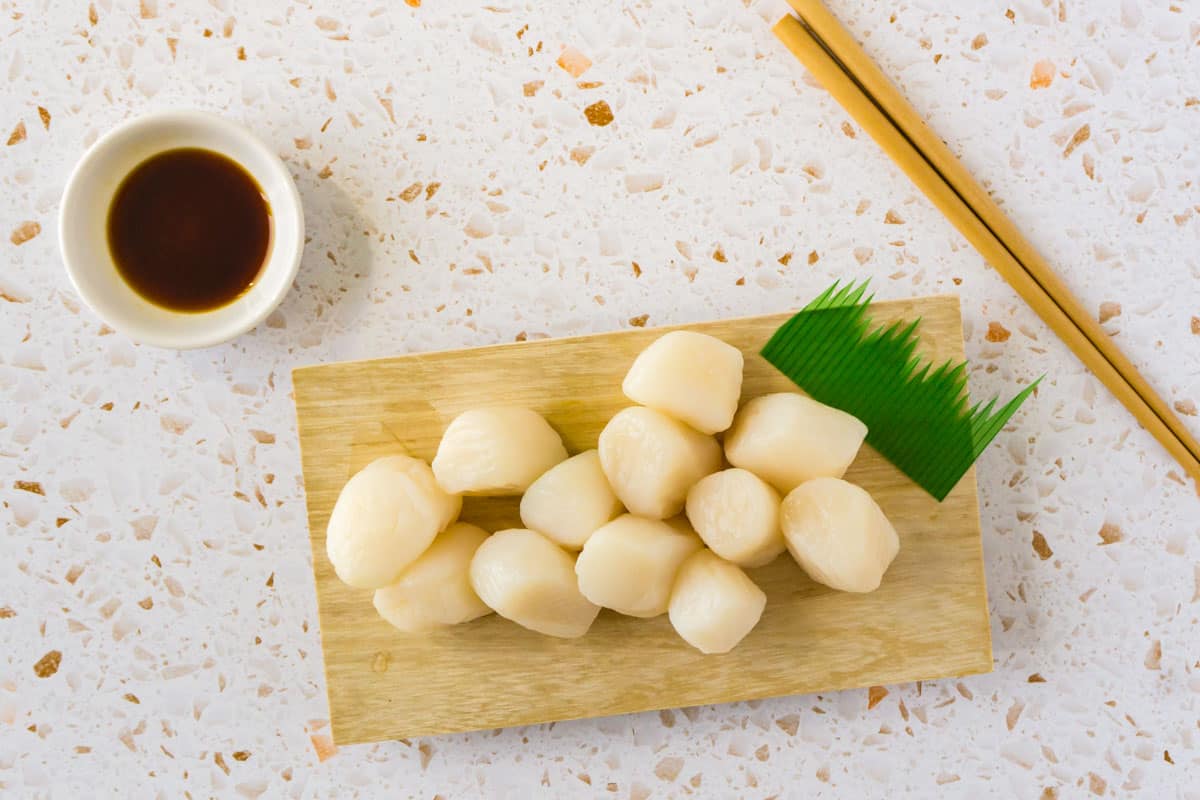
Scallop sashimi, or hotate, is a delicious delicacy with a lot of health benefits. It is often circular shaped and white in color. Hotate also has a very silky texture and has a sweet and soft taste.
They are one of the leanest sashimis and are a great source of antioxidants.
So what is the nutrition profile for scallop sashimi like? Is scallop sashimi healthy?
| Scallop Sashimi | |||||
| Ingredient | Quantity | Calories | Protein (g) | Fat (g) | Carbs (g) |
|---|---|---|---|---|---|
| Scallop | 4 oz | 90 | 21 | 1 | 3 |
| Soy Sauce | 1 tbsp | 10 | 1 | 1 | 0 |
| Total | 100 | 22 | 2 | 3 | |
Scallop sashimi can be very healthy – one 4-ounce serving of scallop sashimi is 100 of calories with 22 grams of protein, 2 grams of fat, and 3 grams of carbs.
This is one of the lowest fat content sashimis, making it a great lean protein source.
Uni
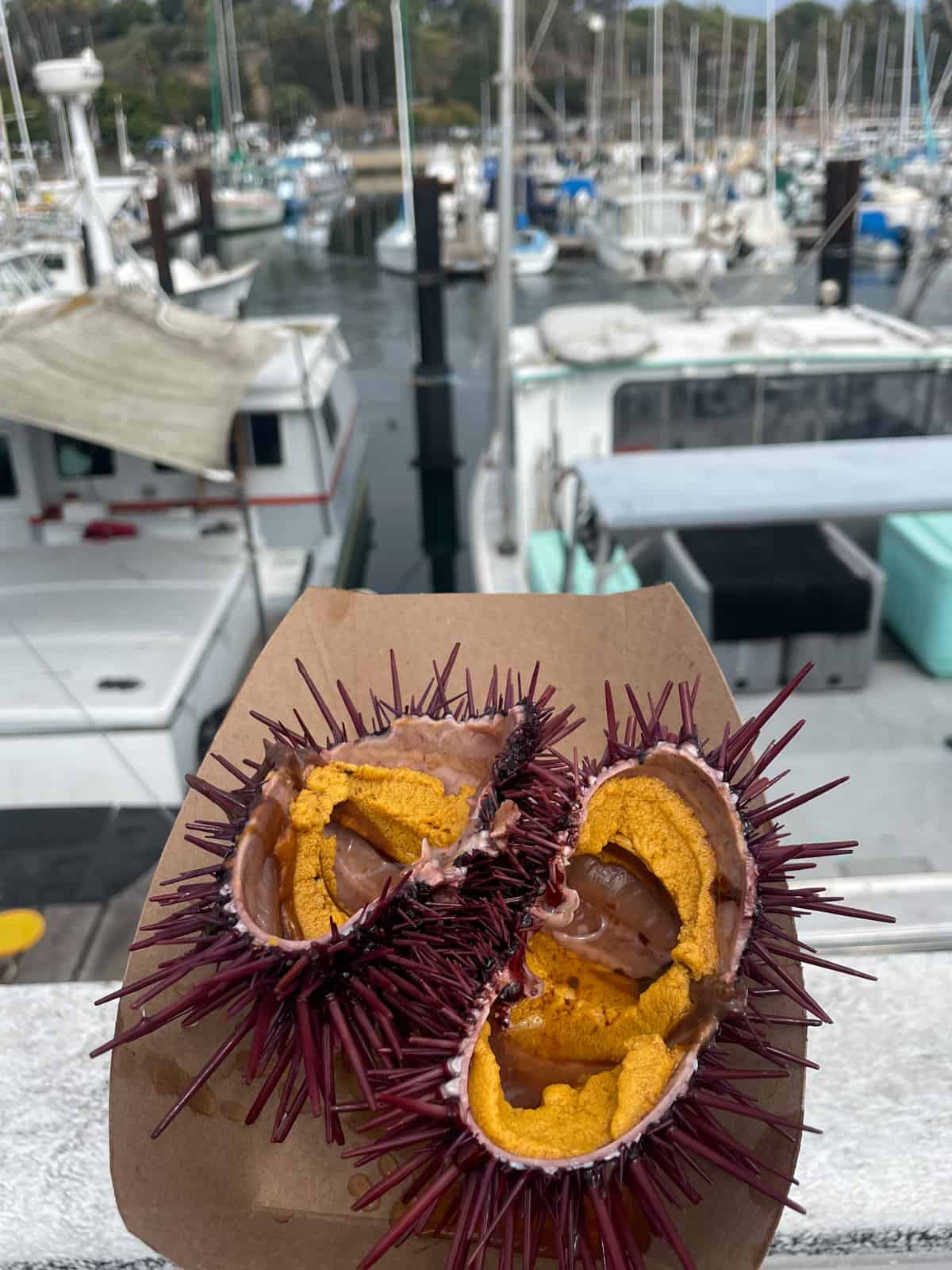
Uni, or sea urchin roe, is a type of seafood that is a culinary delicacy in Japanese cuisine. It is an orange-colored seafood with a distinct flavor that pairs well with many different kinds of dishes and is a delight to the taste buds.
So what is the nutrition profile for uni sashimi like? Is uni sashimi healthy?
| Uni Sashimi | |||||
| Ingredient | Quantity | Calories | Protein (g) | Fat (g) | Carbs (g) |
|---|---|---|---|---|---|
| Uni | 25 g | 40 | 5 | 1 | 2 |
| Soy Sauce | 1 tbsp | 10 | 1 | 1 | 0 |
| Total | 50 | 6 | 2 | 2 | |
Uni sashimi is very healthy since it is low-calorie, protein-packed, and has omega-3s and other micronutrients. A 25-gram serving of uni consists of 50 calories, with 6 grams of protein, 2 grams of fat, and 2 grams of carbs.
Uni is also a super versatile dish that can be used in a wide variety of recipes, such as this delicious Uni pasta carbonara. Check out my Uni Recipes guide to learn more.
Salmon (Sake)
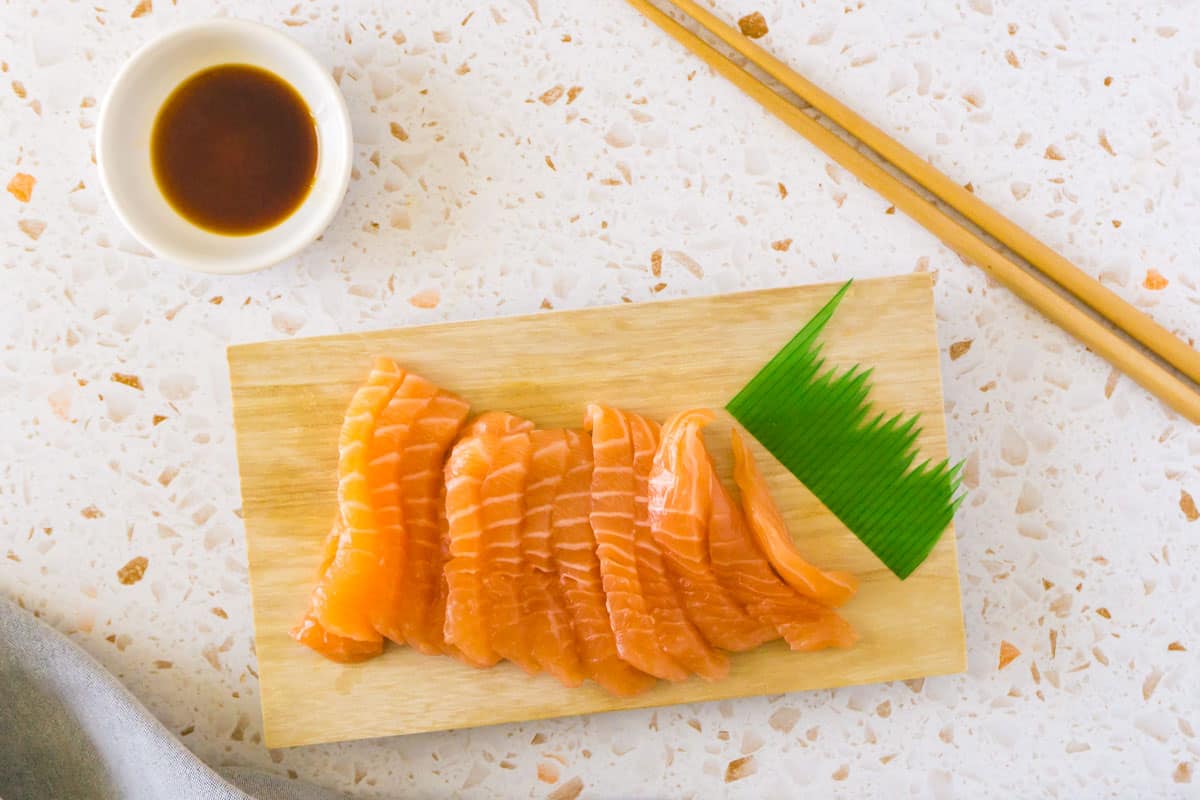
Salmon is one of the most popular types of salmon sashimi in the Western world. It’s delicious, fatty fish that gives it a super silky texture.
So what is the nutrition profile for salmon sashimi like? Is salmon sashimi healthy?
| Salmon Sashimi | |||||
| Ingredient | Quantity | Calories | Protein (g) | Fat (g) | Carbs (g) |
|---|---|---|---|---|---|
| Salmon | 4.02 oz | 234.5 | 23.45 | 15.41 | 0 |
| Soy Sauce | 1 tbsp | 10 | 1 | 1 | 0 |
| Total | 244.5 | 24.45 | 16.41 | 0 | |
Salmon sashimi can be very healthy – one 4-ounce serving of salmon sashimi is 245 calories with 24 grams of protein, 16 grams of fat, and 0 grams of carbs.
Given the higher fat content of salmon, it is much more calorie-dense compared to other types of sashimi. While still healthy, it’s best to portion this mindfully when eating.
Another popular way to enjoy salmon is to make a salmon sushi bake, which is a great option for serving multiple people.
⚡ Potential Risks
Raw food risks – Like the consumption of any raw foods, there is a higher risk of consuming bacteria or parasites. Make sure you are buying sashimi-grade fish if you are making your sashimi at home to prevent food poisoning. This type of fish is proclaimed by the seller to be of the right quality to eat raw
Mercury Content – Like most seafood, sashimi has a higher mercury concentration. Tuna can tend to have higher mercury levels while salmon and shrimps have a lower amount.
Note: According to the FDA, immunocompromised and pregnant women should not eat raw fish due to the higher risk of bacteria and parasite contamination.
💭 FAQs
Sashimi is healthier than sushi as it only contains the lean protein of sushi without the additional carbs and fats from rice, avocado, or sauces that sushi might come with.
It's best to eat sashimi the day that you purchase it, or at least within 24 hours.
Sashimi is generally more expensive than meat given the additional complexity that comes with transporting and preserving the freshness of the fish. Additionally, sashimi-grade fish is typically flash frozen to kill off parasites, so the cost reflects the complexity of this process.


Leave a Reply